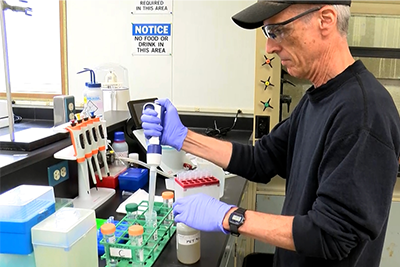COVID-19 Wastewater Surveillance
Tracking the prevalence of COVID-19 among metro area residents
In partnership with the University of Minnesota Genomics Center (UMGC), the Met Council pioneered wastewater epidemiology in the Twin Cities area during the COVID-19 pandemic, by analyzing and reporting findings on the prevalence of SARS CoV-2 entering the Metropolitan Wastewater Treatment Plant in Saint Paul.
Consolidated wastewater surveillance
Today, the State of Minnesota maintains a COVID-19 wastewater reporting system that can detect a variety of viruses in the general population, including COVID-19. The Minnesota Department of Health (MDH) and the University of Minnesota’s Medical School consolidate all wastewater monitoring in the state through the Center for Disease Control’s National Wastewater Surveillance System.
Monitoring data from 38 wastewater treatment plants across the state, including the metro area, are shared through a Minnesota wastewater surveillance dashboard.
Wastewater surveillance of COVID-19 has become an important tool for monitoring trends with the virus, especially as the use of at-home tests has increased. Our Environmental Services division participates in this important partnership by continuing to provide samples from our nine wastewater treatment plants for analysis.
The start of wastewater-based epidemiology in the Twin Cities
 At the start of the pandemic, there was widespread activity on surveillance of SARS-CoV-2 in wastewater. Met Council participated in those early efforts by providing samples to the developing projects and working with the University of Minnesota Genomics Center to investigate methods that the Environmental Services division could apply to generate beneficial information.
At the start of the pandemic, there was widespread activity on surveillance of SARS-CoV-2 in wastewater. Met Council participated in those early efforts by providing samples to the developing projects and working with the University of Minnesota Genomics Center to investigate methods that the Environmental Services division could apply to generate beneficial information.
This wastewater surveillance work started with daily monitoring of influent samples from the Metro Plant in Saint Paul. Our wastewater research and development team developed a fast and straightforward two-step, column-based direct capture extraction method and applied it, along with RT-ddPCR through partnership with the University of Minnesota Genomic Center, to reliably quantify the total amount and genomic diversity of SARS-CoV-2 RNA in wastewater entering the plant.
The results show that the total amount of RNA in the wastewater was a dependable indicator of the levels of clinical cases reported in the treatment plant’s service area while clinical testing was widespread, and trends in the clinical case numbers were accurately reflected in the wastewater signal, providing timely information on the local disease situation and trends to the community.
After widespread clinical testing declined, the wastewater data remained a reliable indicator of local disease prevalence and trends.
- Research preprint – Long-term monitoring of SARS-CoV-2 load and variant composition at a large metropolitan wastewater treatment plant using a simple two-step direct capture RNA extraction, droplet digital PCR, and targeted mutation assays. Steven J. Balogh, George B. Sprouse, Kenneth B. Beckman, Ray H.B. Watson, Darrell M. Johnson, Lee D. Pinkerton, Yabing H. Nollet, Adam W. Sealock, Walter S.C. Atkins, Laura M. Selenke, Joseph A. Kinney, Patrick J.R. Grady, Brandon Vanderbush, Jerry J. Daniel. medRxiv 2024.08.21.24311866
- COVID-19 full data sets – The wastewater surveillance data was made publicly available online throughout the pandemic. The data, along with weekly summary graphs, were sought out by public health officials, the medical community, the media, and others. Access the full data set for the 32 month collection period, beginning Nov. 2020 through June 2023, at COVID-19 Surveillance at the Metro Plant dashboard.
Throughout the COVID-19 pandemic and still today, the Met Council participates in projects to monitor SARS-CoV-2 viral RNA in the wastewater coming to our treatment plants. The team provided samples from all nine plants to a University of Minnesota Medical School project, samples from four plants to several national projects, and samples in response to requests from several external research groups.
We thank the public and interested parties across the country for entrusting us with this important data. We're gratified it was put to good use in making decisions that enhanced health and health care.